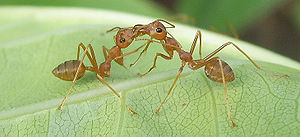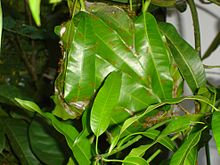- Weaver ant
-
Oecophylla
Temporal range: 47–0 Ma Eocene - Recent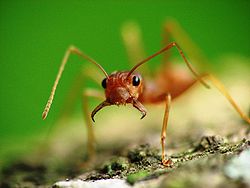
Weaver ant (Oecophylla smaragdina) major worker (Vietnam). Scientific classification Kingdom: Animalia Phylum: Arthropoda Class: Insecta Order: Hymenoptera Family: Formicidae Subfamily: Formicinae Tribe: Oecophyllini Genus: Oecophylla
Smith, 1860Species †Oecophylla atavina
†Oecophylla bartoniana
†Oecophylla brischkei
†Oecophylla crassinoda
†Oecophylla eckfeldiana
†Oecophylla grandimandibula
†Oecophylla leakeyi
Oecophylla longinoda
†Oecophylla longiceps
†Oecophylla megarche
†Oecophylla obesa
†Oecophylla perdita
†Oecophylla praeclara
†Oecophylla sicula
Oecophylla smaragdina
†Oecophylla superba
†Oecophylla xiejiaheensisDiversity 2 species 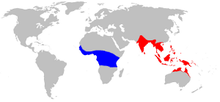
Oecophylla range map.
Oecophylla longinoda in blue, Oecophylla smaragdina in red.[1]Weaver ants or Green ants (genus Oecophylla) are eusocial insects of the family Formicidae (order Hymenoptera). Weaver ants are obligately arboreal and are known for their unique nest building behaviour where workers construct nests by weaving together leaves using larval silk.[2] Colonies can be extremely large consisting of more than a hundred nests spanning numerous trees and contain more than half a million workers. Like many other ant species, weaver ants prey on small insects and supplement their diet with carbohydrate-rich honeydew excreted by small insects (Hemiptera). Oecophylla workers exhibit a clear bimodal size distribution, with almost no overlap between the size of the minor and major workers.[3] [4] The major workers are approximately eight to ten millimeters in length and the minors approximately half the length of the majors. There is a division of labour associated with the size difference between workers. Major workers forage, defend, maintain and expand the colony whereas minor workers tend to stay within the nests where they care for the brood and 'milk' scale insects in or close to the nests. Oecophylla weaver ants vary in color from reddish to yellowish brown dependent on the species. Oecophylla smaragdina found in Australia often have bright green gasters. These ants are highly territorial and workers aggressively defend their territories against intruders. Because of their aggressive behaviour, weaver ants are sometime used by indigenous farmers, particularly in southeast Asia, as natural biocontrol agents against agricultural pests. Although Oecophylla weaver ants lack a functional sting they can inflict painful bites and often spray formic acid[5][6] directly at the bite wound resulting in intense discomfort.
Contents
Taxonomy
The weaver ants belong to the ant genus Oecophylla (subfamily Formicinae) which contains two closely related living species: O. longinoda found in Sub-Saharan Africa and O. smaragdina found in southern India, southeast Asia, and Australia.[7][8] They are provisionally placed in a tribe of their own, Oecophyllini. The weaver ant genus Oecophylla is relatively old, and 15 fossil species have been found from the Eocene to Miocene deposits.[9][10] Polyrhachis and Dendromyrmex are two other genera of weaving ants that also use larval silk in nest construction, but the construction and architecture of their nests are simpler than those of Oecophylla.[2] In Australia, Oecophylla smaragdina is found in the tropical coastal areas as far south as Rockhampton and across the coastal tropics of the Northern Territory down to Broome in West Australia.
The common features of the genus include an elongated first funicular segment, presence of propodeal lobes, helcium at midheight of abdominal segment 3 and gaster capable of reflexion over the mesosoma. Males have vestigial pretarsal claws.[11]
Colony ontogeny and social organization
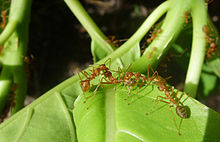 O. smaragdina major workers inspecting and cleaning (allogrooming) another worker on its return to the nest, Thailand
O. smaragdina major workers inspecting and cleaning (allogrooming) another worker on its return to the nest, Thailand
Weaver ant colonies are founded by one or more mated females (queens).[12] A queen lays her first clutch of eggs on a leaf and protects and feeds the larvae until they develop into mature workers. The workers then construct leaf nests and help rear new brood laid by the queen. As the number of workers increases, more nests are constructed and colony productivity and growth increase significantly. Workers perform tasks that are essential to colony survival, including foraging, nest construction, and colony defense. The exchange of information and modulation of worker behaviour that occur during worker-worker interactions are facilitated by the use of chemical and tactile communication signals. These signals are used primarily in the contexts of foraging and colony defense. Successful foragers lay down pheromone trails that help recruit other workers to new food sources. Pheromone trails are also used by patrollers to recruit workers against territorial intruders. Along with chemical signals, workers also use tactile communication signals such as attenation and body shaking to stimulate activity in signal recipients. Multimodal communication in Oecophylla weaver ants importantly contribute to colony self-organization.[13][14] Like many other ant species, Oecophylla workers exhibit social carrying behavior as part of the recruitment process, in which one worker will carry another worker in its mandibles and transport it to a location requiring attention.
Nest building behaviour
Oecophylla weaver ants are known for their remarkable cooperative behaviour used in nest construction. Possibly the first description of weaver ant's nest building behaviour was made by the English naturalist Joseph Banks, who took part in Captain James Cook's voyage to Australia in 1768. An excerpt from Joseph Banks' Journal (cited in Hölldobler and Wilson 1990) is included below:
The ants...one green as a leaf, and living upon trees, where it built a nest, in size between that of a man's head and his fist, by bending the leaves together, and gluing them with whitish paperish substances which held them firmly together. In doing this their management was most curious: they bend down four leaves broader than a man's hand, and place them in such a direction as they choose. This requires a much larger force than these animals seem capable of; many thousands indeed are employed in the joint work. I have seen as many as could stand by one another, holding down such a leaf, each drawing down with all his might, while others within were employed to fasten the glue. How they had bent it down I had not the opportunity of seeing, but it was held down by main strength, I easily proved by disturbing a part of them, on which the leaf bursting from the rest, returned to its natural situation, and I had an opportunity of trying with my finger the strength of these little animals must have used to get it down.[2]
The weaver ant's ability to build capacious nests from living leaves has undeniably contributed to their ecological success. The first phase in nest construction involves workers surveying potential nesting leaves by pulling on the edges with their mandibles. When a few ants have successfully bent a leaf onto itself or drawn its edge toward another, other workers nearby join the effort. The probability of a worker joining the concerted effort is dependent on the size of the group, with workers showing a higher probability of joining when group size is large.[15] When the span between two leaves is beyond the reach of a single ant, workers form chains with their bodies by grasping one another's petiole (waist). Multiple intricate chains working in unison are often used to ratchet together large leaves during nest construction. Once the edges of the leaves are drawn together, other workers retrieve larvae from existing nests using their mandibles. These workers hold and manipulate the larvae in such a way that causes them to excrete silk. They can only produce so much silk, so the larva will have to pupate without a cocoon. The workers then maneuver between the leaves in a highly coordinated fashion to bind them together.[2] Weaver ant's nests are usually elliptical in shape and range in size from a single small leaf folded and bound onto itself to large nests consisting of many leaves and measure over half a meter in length. The time required to construct a nest varies depending on leaf type and eventual size, but often a large nest can be built in significantly less than 24 hours. Although weaver ant's nests are strong and impermeable to water, new nests are continually being built by workers in large colonies to replace old dying nests and those damaged by storms.
Positive and negative interactions with crop plants
Large colonies of Oecophylla weaver ants consume significant amounts of food, and workers continuously kill a variety of arthropods (primarily insects) close to their nests. Insects are not only consumed by workers, but this protein source is necessary for brood development. Because weaver ant workers hunt and kill insects that are potentially harmful plant pests, trees harboring weaver ants benefit from having decreased levels of herbivory. They have traditionally been used in biological control in Chinese and Southeast Asian citrus orchards from at least 400 AD.[16][17] Many studies have shown the efficacy of using weaver ants as natural biocontrol agents against agricultural pests.[18] The use of weaver ants as biocontrol agents has especially been effective for fruit agriculture, particularly in Australia and southeast Asia.[19][20] Fruit trees harboring weaver ants produce higher quality fruits, show less leaf damage by herbivores, and require fewer applications of synthetic pesticides.[20][21] Farmers in southeast Asia often build rope bridges between trees and orchards to actively recruit ants to unoccupied trees. Established colonies are often supplemented with food to promote faster growth and to deter emigration.
Oecophylla colonies may not be entirely beneficial to the host plants. Studies indicate that the presence of Oecophylla colonies may also have negative effects on the performance of host plants by reducing fruit removal by mammals and birds and therefore reducing seed dispersal and by lowering the flower-visiting rate of flying insects including pollinators.[22][23] Weaver ants also have an adverse effect on tree productivity by protecting sap feeding insects such as scale insects and leafhoppers from which they collect honeydew.[23][24] By protecting these insects from predators they increase their population and increase the damage they cause to trees.[25]
See also
- Ant
- Social insects
- Other ant genus containing species that weave nests (though less complex); Polyrhachis
- Where the Green Ants Dream, a 1984 film directed by Werner Herzog
References
- ^ Dlussky, Gennady M.; Torsten Wappler and Sonja Wedmann (2008). "New middle Eocene formicid species from Germany and the evolution of weaver ants". Acta Palaeontologica Polonica 53 (4): 615–626. doi:10.4202/app.2008.0406. http://gap.entclub.org/taxonomists/Dlussky/Oecophylla%20Dlussky08.pdf.
- ^ a b c d Hölldober, B. & Wilson, E.O. 1990. The ants. Cambridge, Massachusetts: Harvard University Press.
- ^ Weber, NA (1946). "Dimorphism in the African Oecophylla worker and an anomaly (Hym.: Formicidae)" (PDF). Annals of the Entomological Society of America 39: 7–10. http://antbase.org/ants/publications/10434/10434.pdf.
- ^ Edward O. Wilson and Robert W. Taylor (1964). "A Fossil Ant Colony: New Evidence of Social Antiquity." (PDF). Psyche 71 (2): 93–103. doi:10.1155/1964/17612. http://psyche.entclub.org/pdf/71/71-093.pdf.
- ^ J. W. S. BRADSHAW, R. BAKER, P. E. HOWSE (1979) Chemical composition of the poison apparatus secretions of the African weaver ant, Oecophylla longinoda, and their role in behaviour Physiological Entomology 4 (1) , 39–46 doi:10.1111/j.1365-3032.1979.tb00175.x
- ^ N. Peerzada, T. Pakkiyaretnam and S. Renaudc. Volatile Constitutents of the Green Ant Oecophylla smaragdina. Agric. Biol. Chem., 54 (12), 3335-3336, 1990 [1]
- ^ Tree of Life Web Project. 2004. Oecophylla
- ^ Ant Web. 2008. Search Oecophylla
- ^ Azuma, N., Kikuchi, T., Ogata, K. & Higashi, S. 2002. Molecular phylogeny among local populations of weaver ant Oecophylla smaragdina. Zoological Science 19:1321-1328.
- ^ Dlussky, G.M et al.,New middle Eocene formicid species from Germany and the evolution of weaver ants. Acta Palaeontol. Pol. 53 (4): 615–626, 2008
- ^ Bolton, B. 2003. Synopsis and Classification of Formicidae. 370 pp. Memoirs of the American Entomological Institute, Vol. 71. Gainesville, FL.
- ^ RK Peng, K Christian, K Gibb (1998) How many queens are there in mature colonies of the green ant, Oecophylla smaragdina (Fabricius)? Australian Journal of Entomology 37 (3) , 249–253 doi:10.1111/j.1440-6055.1998.tb01579.x
- ^ Hölldobler, B. 1999. Multimodal signals in ant communication. J Comp Physiol A 184:129-141.
- ^ Hölldobler, B. 1983. Territorial behavior in the green tree ant (Oecophylla smaragdina). Biotropica 15:241-250.
- ^ Deneubourg, J.L., Lioni, A. & Detrain, C. 2002. Dynamics of aggregation and emergence of cooperation. Biological Bulletin 202:262-267.
- ^ Chen, S. (1991) The oldest practice of biological control: The cultural and efficacy of Oecophylla smaragdina Fabr in orange orchards. Acta Entomologica Sinica, 11:401-407
- ^ Marco S. Barzman, Nick J. Mills, Nguyen Thi Thu Cuc (2005) Traditional knowledge and rationale for weaver ant husbandry in the Mekong delta of Vietnam. Agriculture and Human Values 13(4):2-9 doi 10.1007/BF01530519
- ^ Van Mele, P. 2008. A historical review of research on the weaver ant Oecophylla in biological control. Agricultural and Forest Entomology 10:13-22.
- ^ Van Mele, P., Cuc, N.T.T. & Van Huis, A. Direct and indirect influences of the weaver ant Oecophylla smaragdina on citrus farmers' pest perceptions and management practices in the Mekong Delta, Vietnam. International Journal of Pest Management 48:225-232.
- ^ a b Peng, R. & Christian, K. 2007. The effect of the weaver ant, Oecophylla smaragdina (Hymenoptera: Formicidae), on the mango seed weevil, Sternochetus mangiferae (Coleoptera: Curculionidae), in mango orchards in the Northern Territory of Australia. International Journal of Pest Management 53:15-24.
- ^ Peng, R.K & Christian, K. 2008. The dimpling bug, Campylomma austrina Malipatil (Hemiptera : Miridae): the damage and its relationship with ants in mango orchards in the Northern Territory of Australia. International Journal of Pest Management 54:173-179.
- ^ The Influence of Aggressive Ants on Fruit Removal in the Tropical Tree, Ficus capensis (Moraceae) Donald W. Thomas Biotropica, Vol. 20, No. 1 (Mar., 1988), pp. 49-53
- ^ a b Asian weaver ants, Oecophylla smaragdina, and their repelling of pollinators Kazuki TSUJI, Ahsol HASYIM, Harlion and Koji NAKAMURA Ecological Research (2004) 19: 669–673
- ^ Neal A. Weber, 1949 "The Functional Significance of Dimorphism in the African Ant, Oecophylla Ecology" Ecology 30:3
- ^ Blüthgen, N. Fiedler, K., 2002 Interactions between weaver ants Oecophylla smaragdina, homopterans, trees and lianas in an Australian rain forest canopy. Journal of Animal Ecology, 71:5
Selected bibliography
- Azuma, N., Ogata, K., Kikuchi, T. & Higashi, S. 2006. Phylogeography of Asian weaver ants, Oecophylla smaragdina. Ecological Research 21:126-136.
- Bonabeau, E., Dorigo, M. & Theraulaz, G. 1999. Swarm Intelligence: From Natural to Artificial Systems. NY, Oxford: Oxford University Press.
- Chapuisat, M. & Keller, L. 2002. Division of labour influences the rate of ageing in weaver ant workers. Proc of the Royal Society B 269:909-913.
- Federle, W., Baumgartner, W. & Hölldober, B. 2004. Biomechanics of ant adhesive pads: frictional forces are rate- and temperature-dependent. Journal of Experimental Biology 207:67-74.
- Hölldober, B. & Wilson, E.O. 1977. Weaver ants. Scientific American 237:146.
- Hölldober, B. & Wilson, E.O. 1977. Weaver ants - social establishment and maintenance of territory. Science 195:900-902.
- Hölldober, B. & Wilson, E.O. 1990. The Ants. Cambridge, Massachusetts: Harvard University Press.
- Hölldober, B. & Wilson, E.O. 1994. Journey to the Ants. Cambridge, Massachusetts: Harvard University Press.
- Huang, H.T. & Yang, P. 1987. Ancient cultured citrus ant used as biological control agent. BioScience 37:665-671.
- Kube, C.R. & Bonabeau, E. 2000. Cooperative transport by ants and robots. Robotics and Autonomous Systems 30:85-101.
- Kube, C.R. & Zhang, H. 1993. Collective robotics: from social insects to robots. Adaptive Behavior 2:189-219.
- Lioni, A., Sauwens, C., Theraulaz, G. & Deneubourg, J.L. 2001. Chain formation in Oecophylla longinoda. Journal of Insect Behavior 14:679-696.
- Peng, R.K., Christian, K. & Gibb, K. 1998. Locating queen ant nests in the green ant, Oecophylla smaragdina (Hymenoptera, Formicidae). Insectes Sociaux 45:477-480.
- Sharkey, A.J.C. 2006. Robots, insects and swarm intelligence. Artificial Intelligence Review 26:255-268.
- Van Mele, P., Cuc, N.T.T. & Van Huis, A. 2001, Farmer's knowledge, perceptions and practices in mago pest management in the Mekong Delta, Vietnam. International Journal of Pest Management 47:7-16.
External links
- Weaver Ants - National Geographic, May 2011
- AntWeb - Ants of the world
- Tree Of Life - Oecophylla
- Weaver ant photographs by Alex Wild
- Green tree ants
- Ants as friends. Insect Pest Management on Tree Crops with Weaver Ants by Paul Van Mele and Nguyen Thi Thu Cuc
- A farmer and his ants
- E.O. Wilson Biodiversity Foundation
Categories:
Wikimedia Foundation. 2010.

